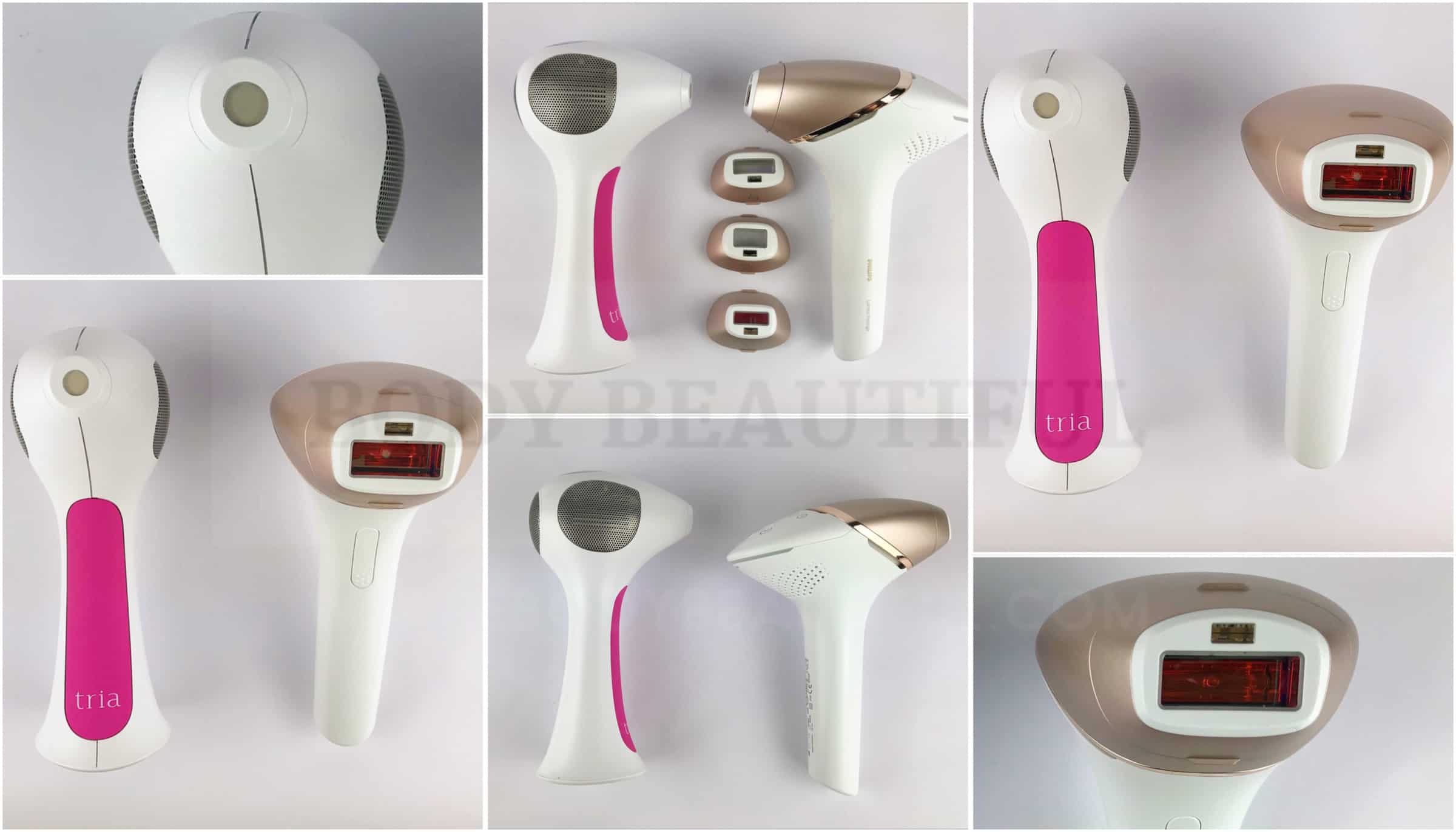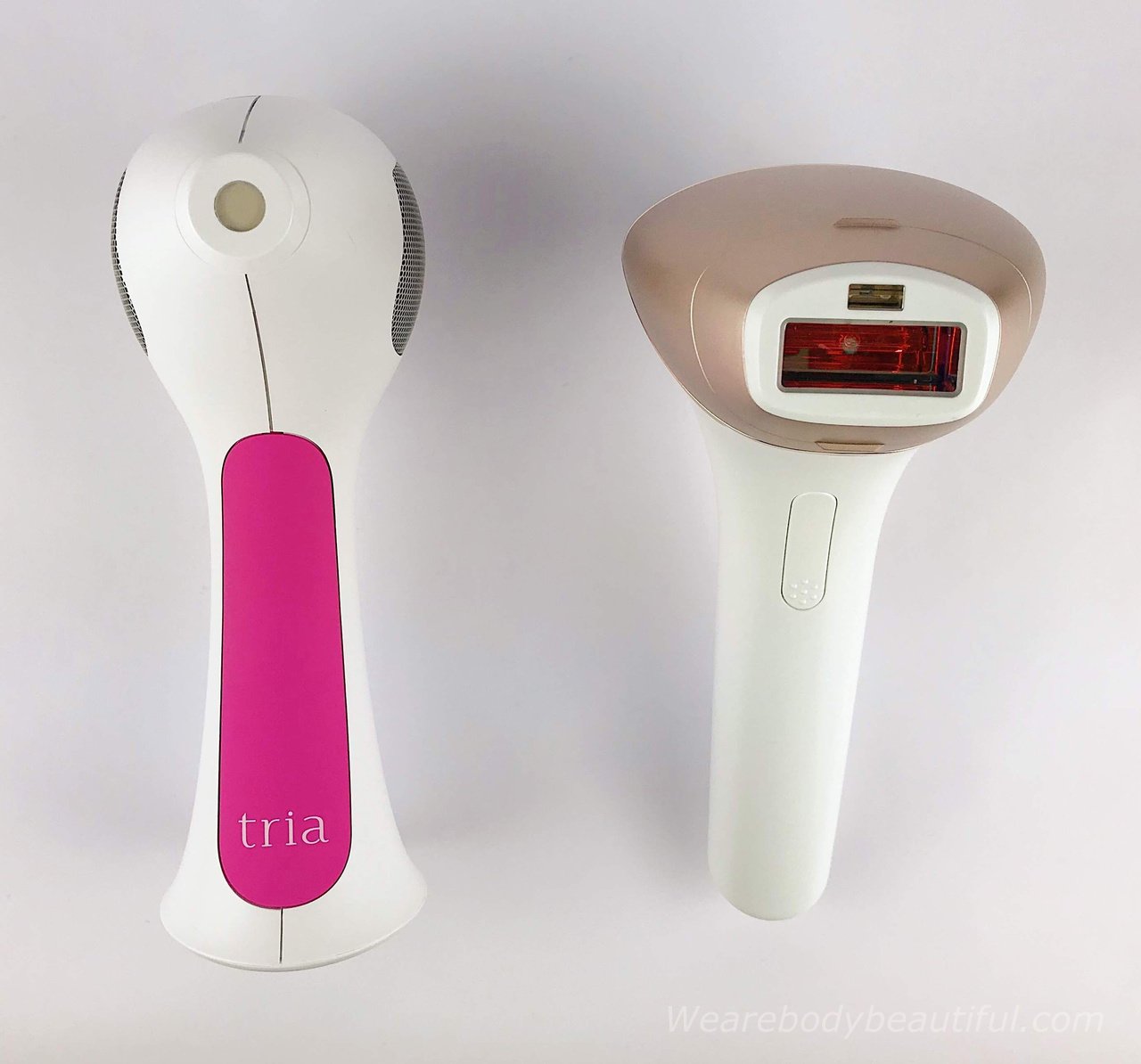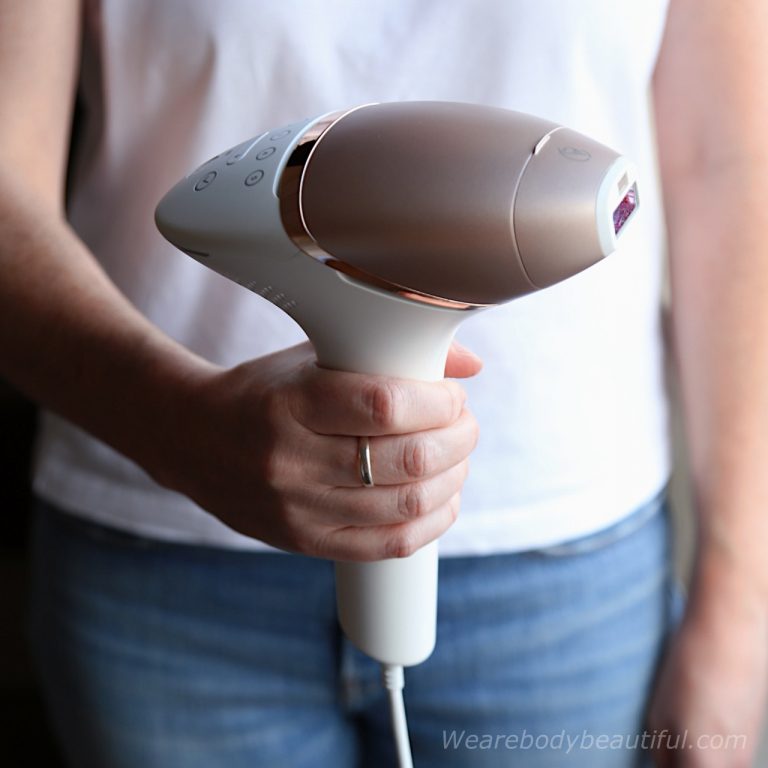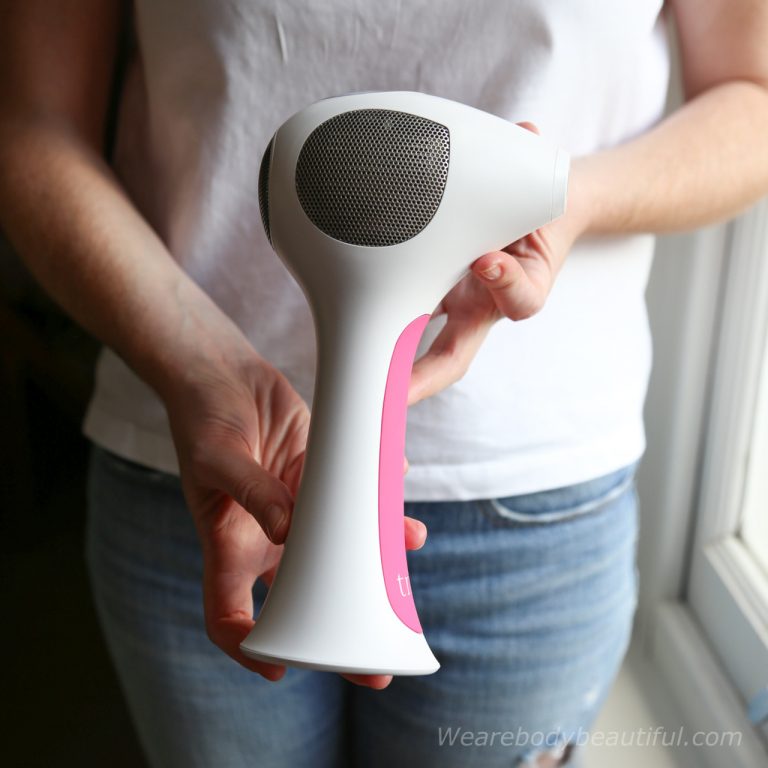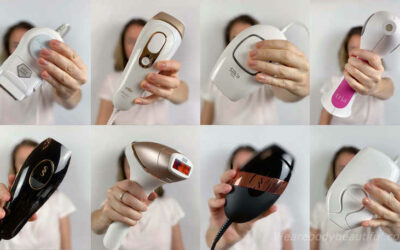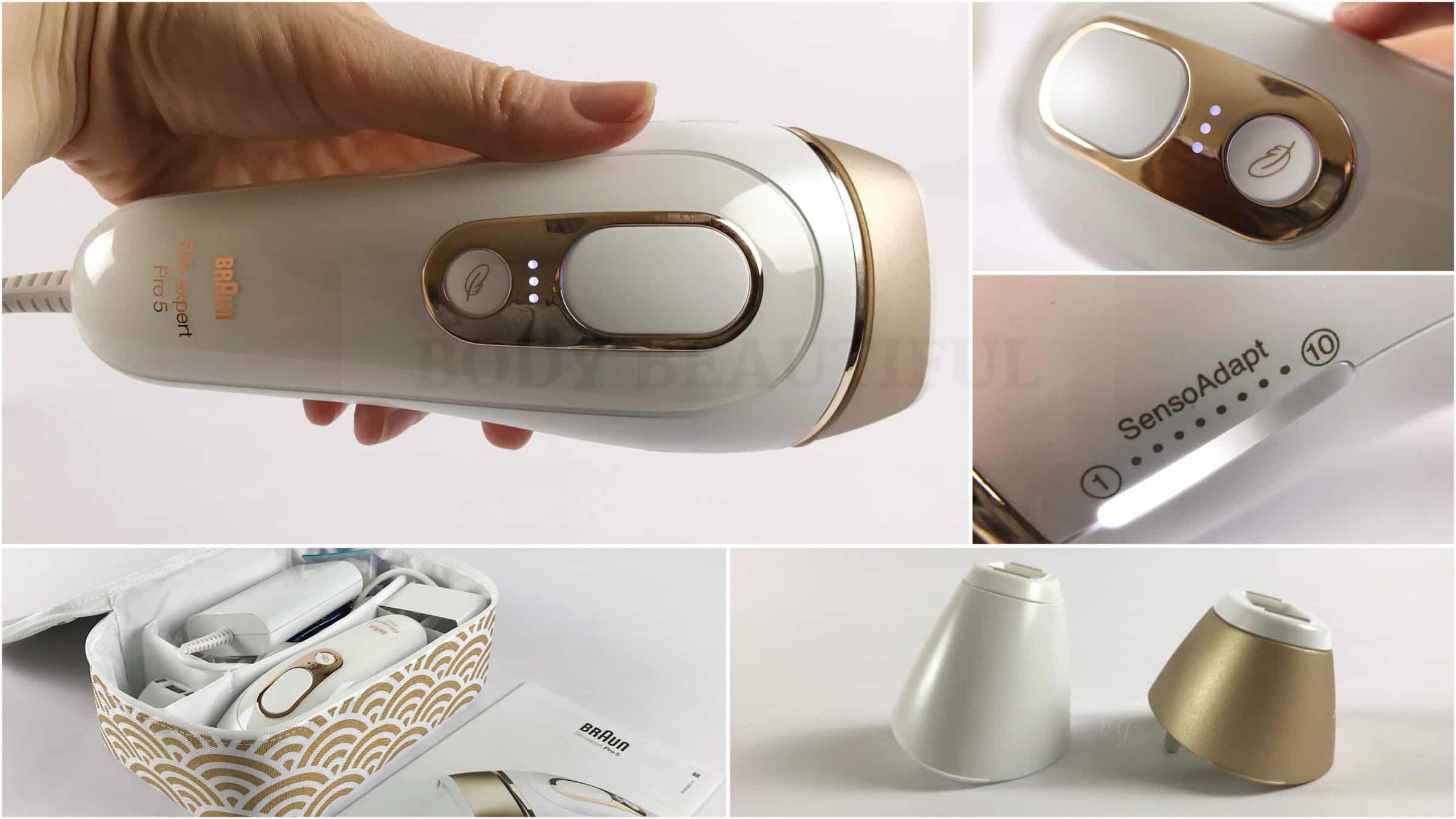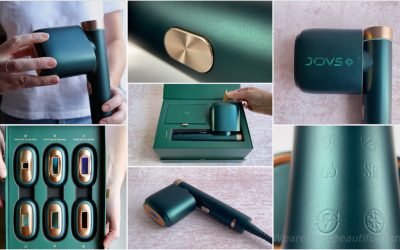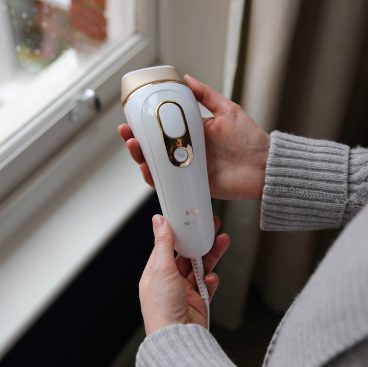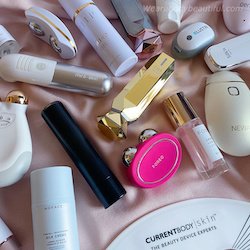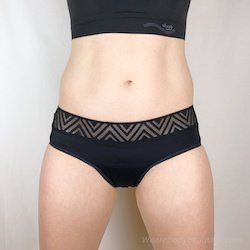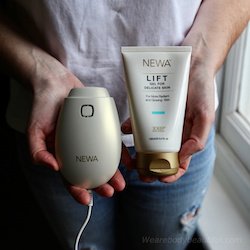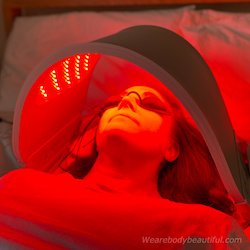The Philips Lumea Prestige use intense pulsed light energy (IPL), and the Tria 4X uses strong laser energy to damage and disable your hair follicles, slowing and then stopping hair regrowth. Periodic top-up treatments keep your skin smooth. Learn more about how home laser & IPL works here.
Quality
Both devices come in neat boxes that are professional, attractive and have all the important info clearly visible. They’re compact and secure with minimal plastic. The Tria stands out for the small details, such as the small ribbon tab inside the box.
The Prestige also comes with a thoughtful storage pouch to protect it from dust and scratches. But hang on to the boxes so you can protect the devices from knocks when stored in a draw. The instruction manuals with both are clear and informative.
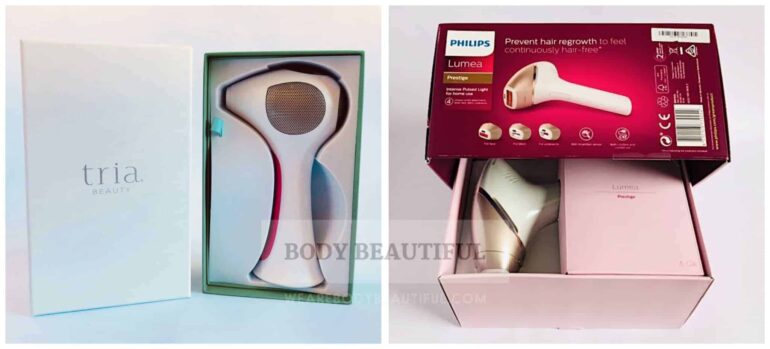
They’re both well-made and with a gun-shape. But they look and feel very different.
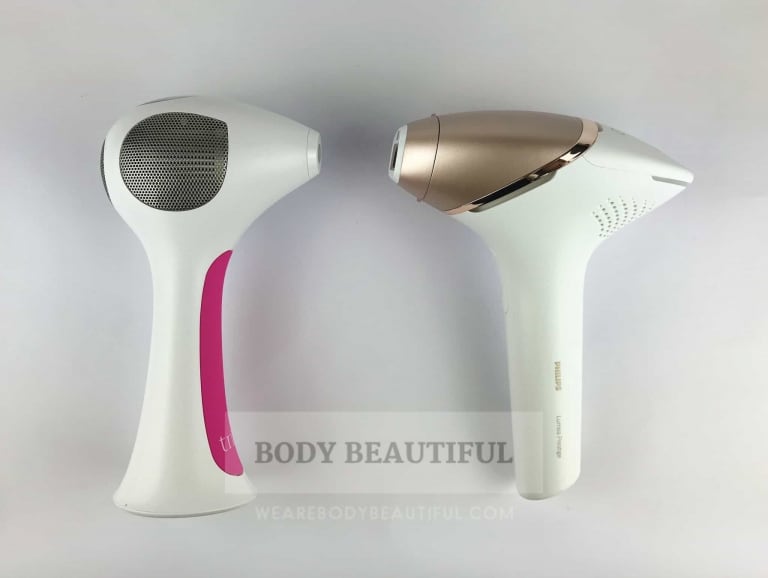
The quirky Tria 4X feels robust enough. It’s white smooth plastic with a slight sheen. It doesn’t creak or bend but the long handle feels a bit hollow. However, I like the pink silicone-type grip and the fluted flat bottom, so it stands up on its own.
But when it comes to build quality, the Prestige is a clear winner. I love the white a rose-gold colourway, craftsmanship and detailing. The materials are top-notch and although it’s plastic, it feels solid, expensive and doesn’t creak or crack. The Tria 4X feels a bit clunky compared to the Prestige, however both are well-designed for the way you move and operate them.
How many flashes?
You’ll get plenty of zappage from each device too.
The Tria 4X Laser keeps zapping until the lithium battery inside eventually degrades. The Prestige IPL bulb has a finite number of flashes before it runs out.
Let’s look at the Prestige first.
The Prestige IPL bulb gives loads of flashes – the earlier models give 250,000 and the newest models 450,000 flashes. Both give plenty, enough for over 15 years of monthly whole-body sessions. And that’s way more than you’ll ever need, because after you’ve done monthly top-ups for 12 months, most people stay smooth for several months at a time. So, you’ll need much less frequent top-ups, possibly just 1 or 2 per year!
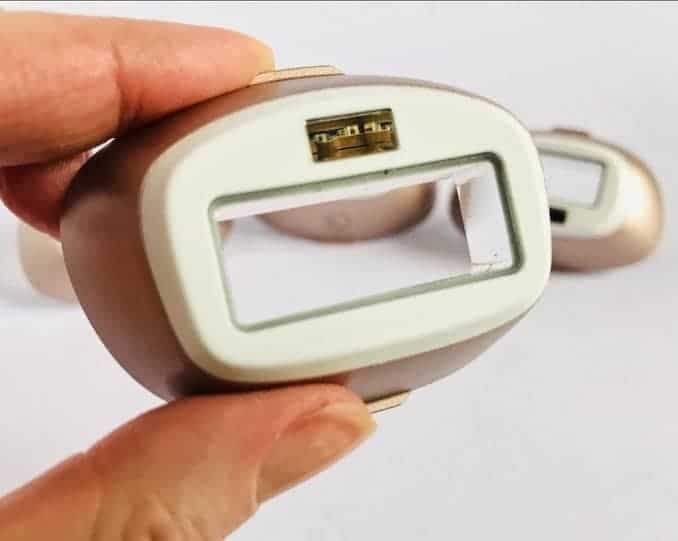
TIP: Although the Prestige with 450,000 flashes sounds far better than 250,000 model, in practice you’ll never use up all the flashes with either. So, both the older and newer Prestige models may as well say unlimited flashes because it’s super unlikely you’ll ever run out.
The Prestige is excellent value and will give you decades of smooth skin all over your body.
The Tria 4X laser is different because it’s a laser. The total number of treatments you get is down to the spot size of the laser and the number of charging cycles you get from the lithium battery. It won’t work on mains-power so it stops working once the lithium battery eventually degrades.
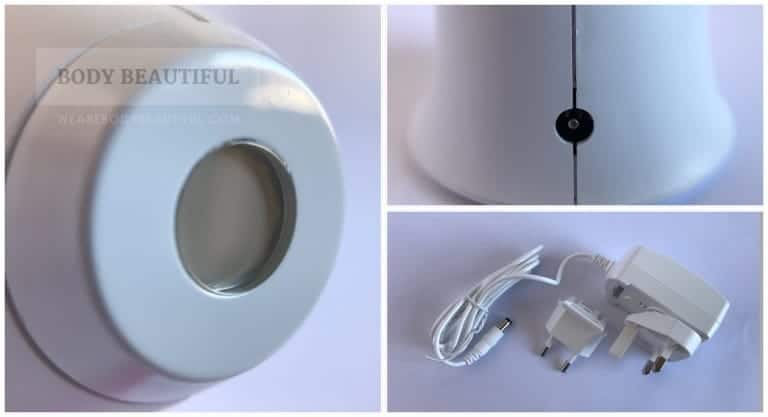
The laser aperture on the Tria is just 5 mm small in diameter and each charge cycle gives you between 500 and 600 pulses. That’s enough to zap your face (upper lip and jaw) and another small area such as underarms. Tria say you get at least 300 battery charge cycles from the battery And if you charge the battery regularly, you’ll likely get many more. So, with at least 300 charging cycles, and if treating small areas only, you’ll get just over 2 years of monthly sessions.
TIP: the Tria 4X user manual says the minimum expected service life of the Tria is 3 years. Charge it every month or so even if the device isn’t in use. This means you’ll get at least 300 charge cycles from the battery, and probably more.
And as per the Prestige, it’s very unlikely you’ll need continued monthly sessions with the Tria 4X. After the start-up stage, and a few top-ups, you’ll need maintenance sessions much less frequently. So, the Tria 4X laser will get you to smooth keep it that way for several years.
And, the laser energy is more powerful than the Prestige’s IPL. So, it does more damage to the hairs so results are longer-lasting. Because of this, you’ll likely need fewer top-up sessions and possibly fewer session overall before you get long-lasting smooth results.
Shape & design
Both devices have a gun-shape but feel very different and with a different movement over your skin too.
The Tria 4X is comfortable to grip on the long fluted silicone-coated handle. There’s no trigger to press, so you can wrap your fingers securely around the narrowest part of the handle and feel no strain. The weight is in the teardrop shaped head so it’s slighly top-heavy but easy and intuitive to manouevre whilst holding at a right-angle to your skin. The LED screen’s on top and the laser aperture is easy to position and see.
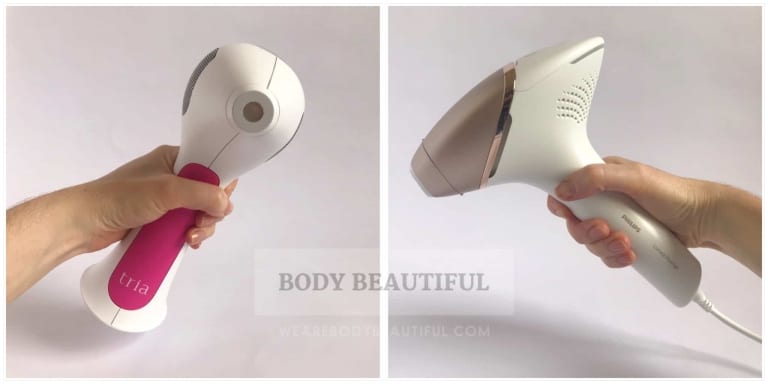
It weighs 600g, because of the lithium battery inside. This is the heaviest of all home, hand-held devices. However, it’s still easy to handle on smaller areas. The weight and alignment perfectly suit the small and precise movements needed to cover your skin.
The Prestige’s gun-shape is more nimble and intuitive. It feels relaxed and balanced with a secure grip on the long, tapered handle. The trigger is easy to find because there’s a braille-like flower on it. You can press it comfortably with your index or middle finger, or thumb if you rotate your grip. The controls and the flash window are easy to see.
It too is heavy at 560g. That’s because it also has a rechargeable lithium battery inside. However, the gun-shape is perfectly balanced and secure to grip, so you can rotate and pivot your wrist without any strain. It’s very easy to position and work around your body.
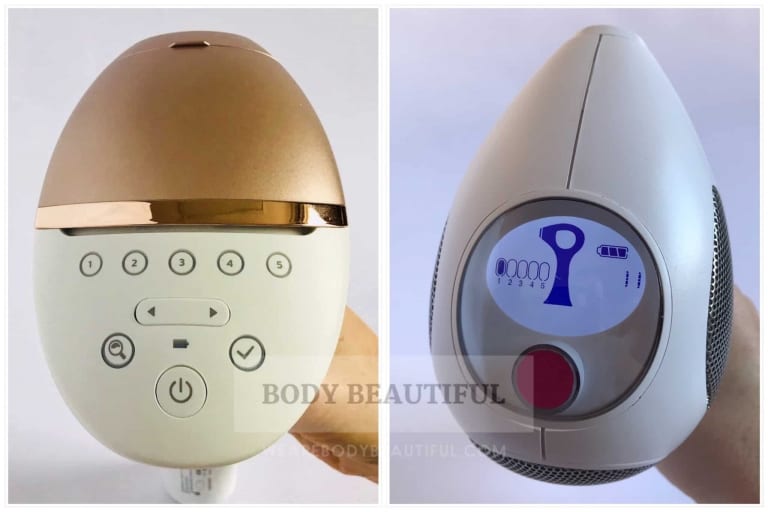

The Prestige works both cordless and on mains-power. The power cable is 2 metres long and high-quality which doesn’t twist or tangle. I love that it’s ready to plug-in and go without waiting for a charge. Use it mainly on mains-power then switch to cordless for tricky to reach areas, or using in the privacy of your bathroom on your tache or lady garden.
The Tria works on battery power only so there’s no cord to get in the way. It takes 2 hours to charge the battery and each charge lasts between 25 and 30 minutes or 500 to 600 zaps.
Power & safety
Both devices are clinically-proven safe and effective for home-use. The Tria 4X also has FDA-clearance. Here’s a comparison of the power and safety features with both:
Power & Safety comparison
Prestige
Tria 4X
2.5 to 6.5 J/cm2
7 to 22 J/cm2
5 energy increments
5 energy increments
Skin tone sensor
Skin tone sensor
Won’t flash if your skin’s too dark
Maually select intensity
Checks & matches intensity to your skin tone
Won’t flash if your skin’s too dark
Maually select intensity
Skin contact sensor
(prevents accidental flashes)
Skin contact sensor
(prevents accidental flashes)
UV filter
Not applicable
Clinically proven
CE certified
FDA-cleared
Clinically proven
CE certified
FDA-cleared
Both the Tria 4X and the Prestige have 5 intensity levels. 1 is low and 5 is high, but because the Tria 4X is a laser, it’s much more powerful than the Prestige.
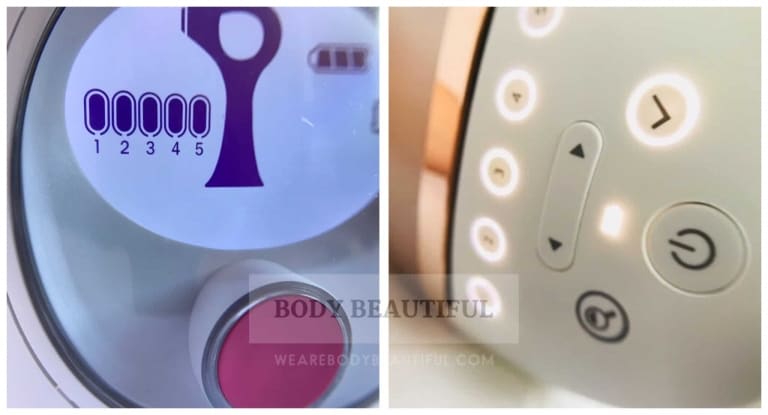
The Tria 4X is around 3 times more powerful than the Prestige.
- The power density output of the Tria 4X ranges from 7 to 22 J/cm2.
- The Prestige ranges from 2.4 to 6.5 J/cm².
The Tria 4X is the strongest of all home-use light energy hair removal devices. And it’s widely acknowledged that the stronger intensity the better your results, so it follows that the Tria 4X promises the longest-lasting results of all home-use laser and IPL hair removal systems. This means, although you’ll still need top-up sessions, you’ll likely need fewer or much less frequently overall .
Sounds great! Loads of people choose the Tria 4X over any IPL hair removal systems because it’s most powerful. They want the best possible results in the shortest time. However, it’s not the best choice for treating large body areas. You can learn more about this later.
To protect you, both devices have a skin sensor around the flash window and laser aperture. They won’t flash unless they detect your skin covering the entire window. This means it’s not going to accidentally flash into anyone’s eyes.
And to protect darker skin tones, you get a skin tone sensor with both too.
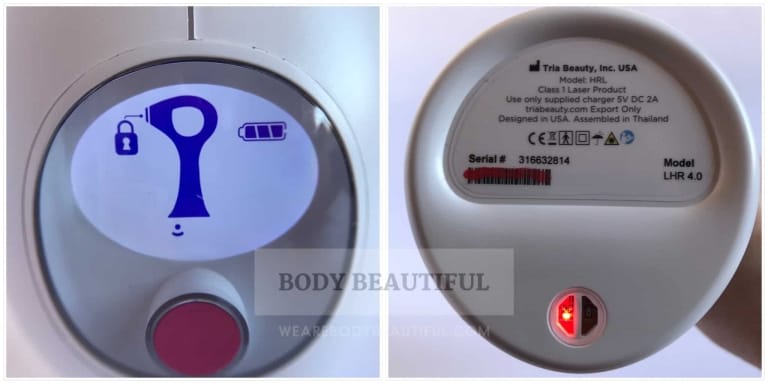
The Tria 4X sensor is on the bottom of the handle. Place it on skin in your treatment area and it checks for a safe tone to unlock the device. All intensity levels are safe for Fitzpatrick types I to IV. It’s up to you to choose your most comfortable intensity level. More on that later.
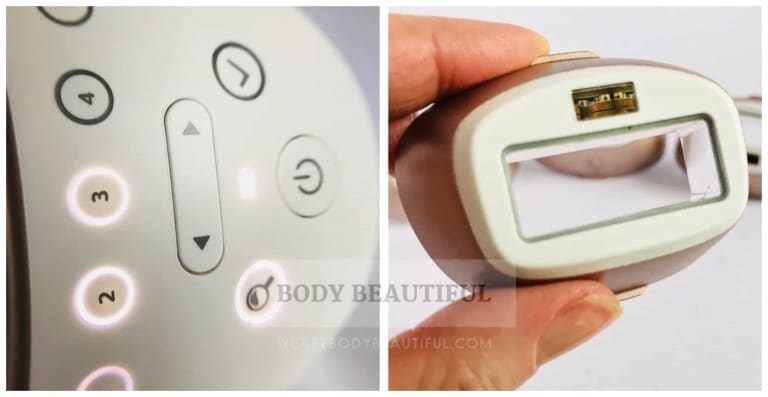
The Prestige sensor is a bit more advanced because you must not use the high IPL levels on darker skin. The sensor is the small window above the larger flash window. It also checks for a safe tone and flashes red if it detects a tone that’s too dark (Fitzpatrick type VI). It periodically checks your skin tone during treatment too.
And it has an additional helpful feature called Smartskin Sensor too. Press the magnifier button and it checks then suggests the best IPL level for your skin tone. But you stay in control, and can adjust it down a notch if it feels too intense.
Do they hurt?
This depends on the individual. But based on the available user feedback it’s fair to say there are more reports of pain with the Tria 4X laser.
Some reviewers say the Prestige is painful, but most of these have darker skin tones. TIt’s described as an uncomfortable tinging sensation, but that’s much more bearable than waxing or epilating. And many more say it’s pain-free.
For the Tria 4X however, it’s notably different. For a start, Tria call the intensity settings “comfort levels”.
Uhoh.
A notable number of both positive and negative reviewers say it HURTS. The pain varies but it’s a hot topic in the online feedback.
So, why does it hurt more than the Prestige?
Just like the Prestige, the Tria laser targets melanin in the dark hair follicle. But the Tria’s higher intensities create much more heat and thus damage. It’s this increased heat which means it can hurt.

Some reviewers use Tria’s SmoothStart Calming Gel, or the cheaper alternatives ice or lidocaine gel to numb their skin. Overall, the pain-factor feedback is a much bigger percentage compared to the Prestige and other home IPL reviews.
Unfortunately, there’s no way to know if you’ll feel pain. But be aware it’s possible and weigh this up in your decision.
Legs & large areas?
❌ The Tria 4X is painfully slow and difficult to cover large areas. Each zap covers 5mm, you need several charges and high levels of concentration and precision. It’s not suited to large body areas.
✔ The Prestige is designed to fit your contours and is fast to cover large areas. Each flash is quick and covers a large area, and mains-power means non-stop operation. It’s perfectly suited legs and large areas, as well as small.
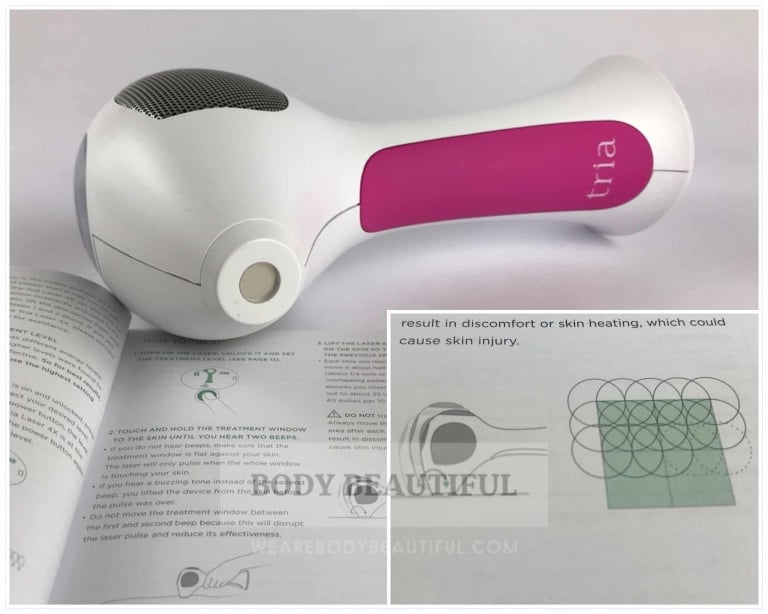
The Tria 4X covers a tiny 5mm area each pulse. Because it’s such a small movement, you must have a close-up view of the treatment area. Therefore, you’ll need a helpful assistant for backs of legs and knees.
And the battery is limited to 30 mins of use (or 500 to 600 zaps). One full leg needs 2 to 4 charging cycles so could take a total of 10 hours including charging time! This means you need a way to track or mark off where you’ve zapped. Then wait 2 hours for it to charge and pick up where you left off.
For large areas like legs or torso it takes a lot of time, organisation and commitment to complete your treatments. But it’s manageable for small areas done in 30 minutes.
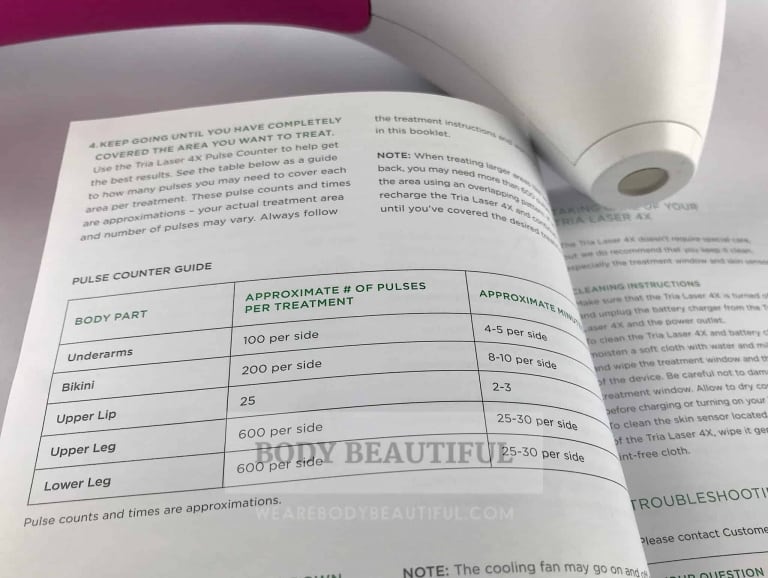
It’s easy to treat your face and underarms by yourself. A very thorough bikini line requires some bending and twisting, or a friendly assistant. And you can treat your face and a couple of small areas with one charge e.g. your upper lip, chin, jawline and a pair of underarms or both sides of the bikini line.
So, what about the Prestige?
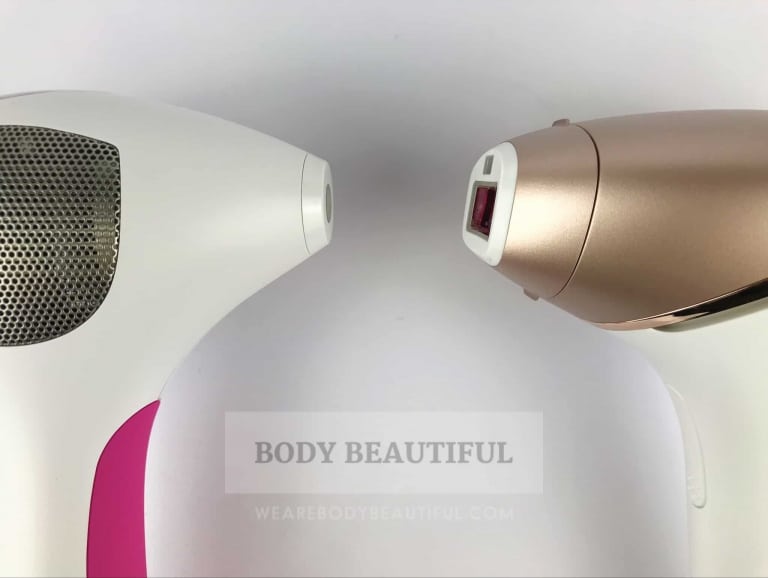
The Prestige is the perfect choice for face, small and large areas or full body treatments done in one session. It takes me 35 to 40 minutes for the whole lot (using corded with mains-power).
And that’s because it has some special features.
Firstly, there’s no need to wait for the Prestige to charge. Use it non-stop with mains-power and finish a full body treatment in one sitting. Swap to cordless just for tricky, hard to reach areas or on small areas in the privacy of the bathroom.
Second, it’s got different size and shape flash windows ranging in size from 2 cm2 to 4.1 cm2. Waaay bigger than the Tria 4X. Some are curved too (no other device has these). They fit the contours of your body so it’s much easier to get good contact and a flash without any fuss. It’s easy to ‘glide’ over your skin too. I love the large curved-in body window because it’s perfect for legs,knobbly-knees, and torso (bum too!)
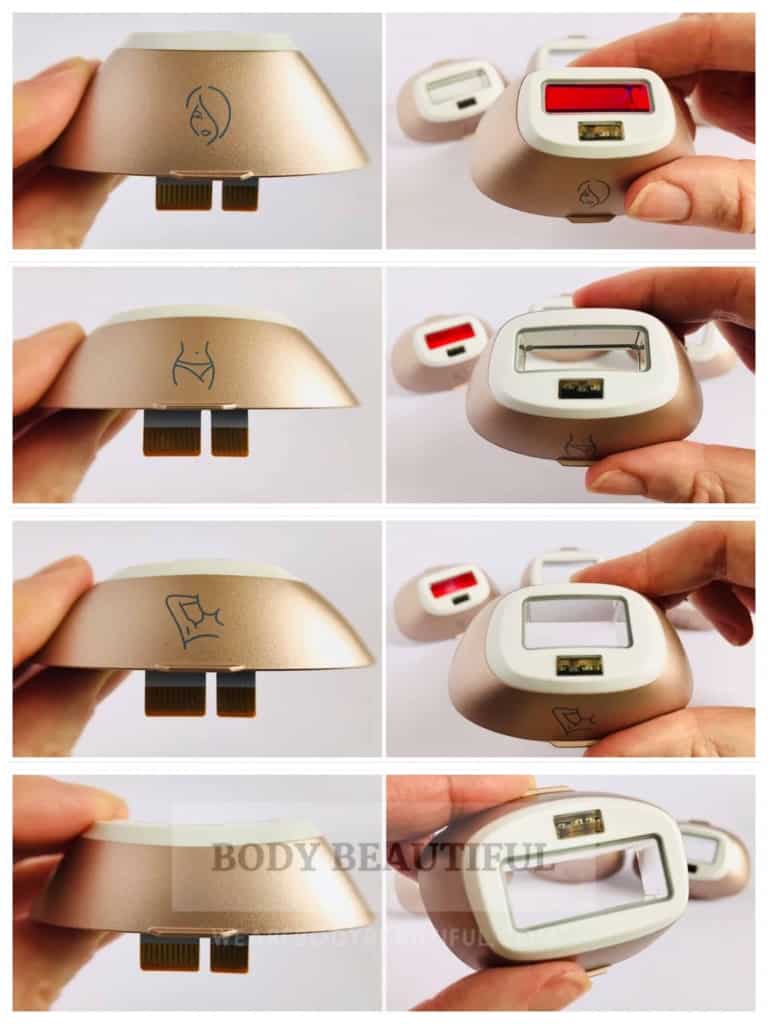
And finally, it’s fast to cover your skin in flashes so you won’t get bored or lose your place. It flashes every 2 seconds on level 5 (when corded). Keep the trigger pressed and slide the Prestige over your skin the height of the flash window each time. The curved attachment makes it easy to get a flash. It’s just awesome for your legs. I can meticulously cover a full body in around 40 minutes.
And with a bit of twisting, bending and a full-length mirror you can see and reach most body areas by yourself i.e. backs of legs and knees.
It’s one of the best choices for large areas or full body treatments done in one session.
Treatment schedule & results
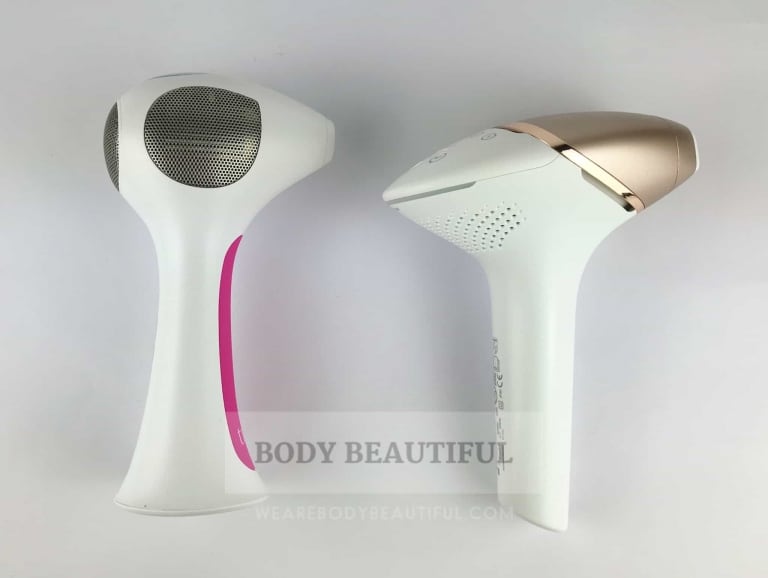
First, let’s check the start-up regimen for both.
Use the Prestige for 4 or 5 sessions every 2 weeks (taking up to 8 weeks) to get smooth skin. Then less frequent touch-ups every 4 to 8 weeks to maintain your results.
Use the Tria for 8 sessions, one every 2 weeks, or until you’re satisfied. It takes up to 3 months to see significant results. Then you can do touch-ups or additional treatments as you need them.
It can take a session or two to see any change. After between 2 to 5 sessions you’ll see a gradual reduction in the number and thickness of your hairs. Hair grows slower and becomes finer, softer and lighter too. You’ll need to shave less frequently. Bald patches start to appear until all your skin is silky smooth.
Both devices give permanent hair reduction, but Tria say after a total of 12 sessions their results are permanent. You can learn more about this permanent statement here.
With both devices you must do the start-up and several top-up sessions for long lasting results. Stop before and the hair grows back. You’ll likely find you need top-ups much less frequently after you’ve done several sessions.
Related: learn why top-ups are crucial & more about long term results
Prestige vs Tria 4X summary

Consider the Tria 4X if you have fair skin and want your longest lasting results, but on face or small body areas only. And if you don’t care if it hurts. Consider the Prestige for darker skin tones (up to fitzpatrick type V) and if you want to treat small and/or large body areas and face. It’s fast, precise and one of the most powerful home IPL devices, and a top recommendation. It’s also a better choice on smaller areas if you don’t have much spare time, because you’ll be done in a matter of minutes, versus up to 30 mins with the Tria 4X.
Here’s a quick summary table of the spec, test and performance data above and then a round-up of the pros and cons to help you decide:
Everything comparison
Philips Lumea
Prestige
Tria
4X Laser
Face, small bits, legs & large areas
Face & small bits
(not large areas)
💰💰💰💰
💰💰💰💰
Clinically proven
CE certified
FDA-cleared
Clinically proven
CE certified
FDA-cleared
2-year warranty
1-year warranty
UK
100-day
money back guarantee
UK & US
60-day
money back guarantee
Mains-power
Cordless / battery
Cordless / battery
Large curved body flash window
Small flat facial window
Curved-out bikini, underarms & precision windows (varies with some models)
5mm laser aperture
560g
600g
250,000 or 450,000 flashes
15+ years of monthly use
300 charging cycles (minimum)
Several years of use
2.5 to 6.6 J/cm2
5 energy increments
7 to 22 J/cm2
5 energy increments
Skin tone sensor
Skin tone sensor
Won’t flash if your skin’s too dark
Maually select intensity
Checks & matches intensity to your skin tone
Won’t flash if your skin’s too dark
Maually select intensity
Feels warm to hot.
Lower a notch if it stings!
Feels warm to hot and can hurt.
Lower a notch if it stings!
10 mins per full leg (high)
40 mins for whole-body
Battery lasts 30 mins
Face & a couple of small areas
4 to 5 sessions (1 every 2 weeks) then top-ups every month or so.
More top-ups = longer lasting results.
8 sessions (1 every 2 weeks) then top-ups every month or so.
12 sessions total for permanent results.
Superb quality
Comfy, ergonomic gun-shape
Curve-hugging easy-flash windows
Cordless option
Helpful check & match intensity
Fast, steady & precise
Good quality
Comfy, intuitive gun-shape
Easy to handle
Most powerful
It’s quite big & heavy (but balanced)
Quite heavy
Too much effort & time for large areas
Difficult to zap backs of legs, torso, bum ets
Can hurt for some
I hope you’ve found this comparison review helpful. If you need more information check out the Lumea Prestige review or the Tria 4X Laser review. Or you can check prices on the links down below.
View Prestige & Tria 4X deals
Found this review helpful? Please support future reviews and shop via these links. I earn a small commission, but your price stays the same.
Philips Lumea Prestige deals
BODY5
Use this code at CurrentBody for an extra discount!

